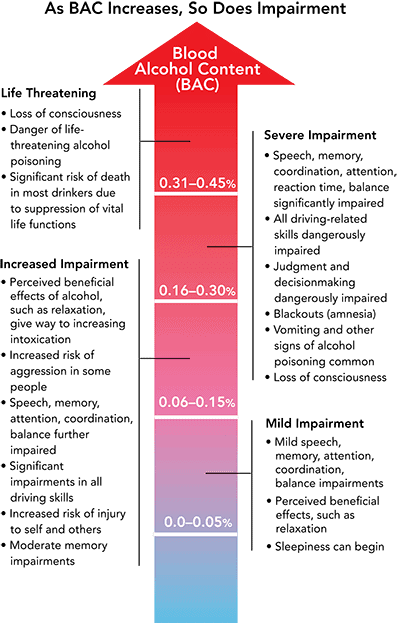We would never knowingly ingest cyanide or arsenic. We associate them with their toxic effects and see them as poisons that we would never put in our body. However, alcohol is something that many people ingest on a regular basis with no such association. Alcohol is often associated with relaxation, loss of inhibition and having an enjoyable time. Very few people are actually aware of the fact that alcohol has its own toxic effects and can poison a person just the same.
Alcohol is processed in the body by the liver and over time is excreted as a waste product by the kidneys. However, the liver has its limits. The liver can process approximately one drink an hour. Anything more than a drink per hour remains in the blood, affecting a person’s blood alcohol content (BAC).
Blood Alcohol Content
We tend to begin to feel the effects of alcohol when we reach a level of .020 BAC. This in the average 150-pound person is accomplished by drinking a little over one drink per hour. We begin to feel relaxed and less inhibited with a BAC of .040 which can occur for that same 150-pound person when drinking a little more than two drinks per hour. As soon as we hit .060 our judgement is usually noticeably impaired, and by .080 our reaction times and muscle coordination are impaired as well.
In most states .080 is the legal intoxication level. This level of intoxication can be accomplished with as little as 4 drinks an hour for some people. BAC is not just affected by drinks per hour and liver metabolism; it also depends on the size, health and prior food intake of the drinker. While it can be quite simple to memorize a simple calculation based on all these factors and monitor your own drinking throughout the night using this calculation, there is a basic rule of thumb to avoid drinking to excess. It is generally a good idea to stick to one alcoholic drink per hour and to drink water in between.
How much is one drink?
It is important to have some definitions clearly explained in following these guidelines. The first of which is a single drink. Not all types of alcohol are equal. One drink or rather one serving of alcohol is typically defined as 12 oz. of beer, 5 oz. of wine, 8 oz. of malt liquor or 1.5 oz. hard liquors. The other term to be clarified is alcohol poisoning (or alcohol toxicity), which is usually defined as a BAC of .100 or greater.
At this point, there is obvious reaction time and motor control deficits, and often vomiting. As the BAC climbs, people may begin to experience blackouts, lose consciousness and stop breathing. A .450 is largely considered a fatal BAC. While most BAC calculators (widely available online) would point out that it would take 20 12 oz. beers, or 100 oz. (1 bottle) of wine, or 30 oz. of hard liquor (20 shots) an hour to get a BAC this high, you must remember that this is a simple estimation and does not take into account your specific liver metabolism rate, the percentage of alcohol in your drinks, the amount of food in your system, your overall health (including liver and kidney disease), other potential chemicals in your system (other drugs or prescription medications), or your individual tolerance level.
Alcohol Poisoning Signs
You would think that something like alcohol poisoning would be pretty rare since most people drink to have a good time and escape their problems rather than cause more. However, statistics show that there are over 2,200 deaths from alcohol poisoning in America each and every year. These deaths occur at an average rate of about 6 per day. That doesn’t include the many survivors who suffer from many negative side-effects, some of which can be liver disease, kidney disease and brain damage.
How do you know if you or a friend is suffering from alcohol poisoning? Signs to look for include confusion, vomiting, seizures, slow or irregular breathing, pale skin (sometimes a blue tinge to the skin), low body temperature and loss of consciousness. Many of these signs are associated with nights spent out drinking or parties that involve drinking and are often overlooked as the natural side-effects for someone who can’t hold their liquor. The truth of the matter is that alcohol poisoning is actually occurring in these situations.
Every time you hear a story about someone dying after drinking at a party or after being hazed by friends, you think “Oh, how tragic!” but you rarely think “That could have been me.” If you have ever gotten intoxicated to the point of confusion, vomiting or passing out it has in fact happened to you, if you survived you are one of the lucky ones. What should you do if you suspect alcohol poisoning?
What to do if Alcohol Poisoning Occurs
 Number one is you should call 911. You/your friend might need to be rushed to the hospital to have a stomach pump. After the call to medical professionals is made, stay with the drinker, never leave them alone, keep them warm, and force them onto their side (if you can’t keep them sitting or standing up) if they are vomiting. Do your best to keep the drinker awake and conscious. DO NOT try to force them to sober up by forcing them to ingest caffeine or by putting them in a cold shower. Keep them hydrated with water.
Number one is you should call 911. You/your friend might need to be rushed to the hospital to have a stomach pump. After the call to medical professionals is made, stay with the drinker, never leave them alone, keep them warm, and force them onto their side (if you can’t keep them sitting or standing up) if they are vomiting. Do your best to keep the drinker awake and conscious. DO NOT try to force them to sober up by forcing them to ingest caffeine or by putting them in a cold shower. Keep them hydrated with water.
Who is this Happening to?
We tend to associate alcohol poisoning with young, immature high-school and college age binge drinkers, and while they do represent a sizable percentage of the people who suffer from alcohol poisoning there are also some surprising populations affected as well. The majority of deaths from alcohol poisoning actually occur in middle aged men.
Binge drinking is defined as drinking more than 4-5 drinks or more an hour. While we do see a lot of binge-drinking among younger drinkers, we tend to see it less frequently; in addition these young people are often in better health and are often able to tolerate higher amounts of alcohol. The CDC reports that most people who binge-drink are not alcoholics. However, one of their recent studies found that two-thirds of those who reported binge drinking reporting doing so 10 or more times a month.
Although statistics show that overall underage drinking is on a decline and many credit the multiple alcohol and drug education programs for this decline, there are a few things you need to remember about published statistics.
Statistical Interpretation (Stats can lie.)
The first is that many statistical data collection procedures include self-reports and rely on participants telling the truth. While people may have various reasons for lying about their drinking behavior despite the promise of anonymity, we are forced to assume their truthfulness. Another issue is the fact that drinking, even excessive drinking seems to have been normalized in our society. Unless someone gets sick, dies or breaks the law, their drinking habits may never come to light at all. Thirdly, as I tell my students in school repeatedly, the data collected in research studies is really only representative of those people who participate in research studies and we should be careful when generalizing or extrapolating from that data.
Preventing Alcohol Poisoning
Alcohol poisoning seems like it should be a problem for bartenders and party hosts, it is really a problem for everyone.
The shocking number of accounts of people dying from alcohol poisoning when they could have survived if they had timely assistance indicates a severe lack in awareness of the effects of moderate to heavy drinking. While bartenders receive special training in recognizing the signs of intoxication and methods for diffusing tense situations involving alcohol, the most the average party host can do is ask guests to maintain some moderation in the drinking in the hopes they don’t embarrass themselves or others.
People drinking on their own at home without trained observers fall into an entirely different risk category. It almost goes without saying that every person who ingests alcohol or spends times with those who ingest alcohol needs to understand the potential effects. Drinks should never be provided more than one at a time and a drink should never be served to an already intoxicated person. There are too many unknown factors and it is impossible to continuously monitor BAC as everyone’s metabolism is different. We have gotten people in the habit of having designated drivers and knowing how to recover from a hangover, our next obstacle should be educating the general public about the need for moderation and prevention of hangovers.
Intoxication is not only an issue when it leads to barfights and car accidents, the alcohol itself can do just as much if not more damage than the resulting behavior. Alcohol can be a poison. It can be just as dangerous as cyanide and arsenic. The significant difference of course is that cyanide and arsenic come with warnings, usually something pretty obvious including the universal symbol for poison, skull and crossbones.
Alcohol does not come with such warnings. Alcohol is commercially advertised and the associated images are usually of people having a good time, making friends, enjoying favorite pastimes etc.
Alcohol can taste good, it can relax a person and it can lower a person’s inhibitions enough so that if they may feel more social than if they were not drinking. But it must be considered carefully and thoughtfully as the powerful sedative that it is. The more your drink the more impaired your judgement can become and the less likely you are to carefully consider the effects of the alcohol on your brain, body and behavior. You need to have a plan or strategy in place in advance or next time you go out to “have a good time” you just might be one of those unlucky 6 people per day who succumb to alcohol poisoning and die. If you survive you may impair your physical and/or mental health in irreparable ways. You may also assume that as long as you are spending time with friends and family who are close to you that you will be kept safe from such situations.
Real Life Cases
That is no doubt what Timothy Piazza, a Penn State University sophomore and Beta Theta Pi fraternity pledge, thought when while surrounded by classmates and friends he performed a drinking ritual known by the fraternity as “the gauntlet”. When Piazza was unable to stand and subsequently fell down the basement stairs of the fraternity house, his behavior was ignored by some, received with irritation by others and treated with panic by yet others.
He was left alone at the bottom of the steps for several hours and later carried upstairs, tossed on a couch, slapped and splashed with liquid in an attempt to wake him, eventually despite criticism from others one fraternity brother called for help but it was later learned that this was not until after attempts to cover up the night’s activities and the fraternity’s possible negligence. Timothy was later that night pronounced dead at a local hospital.
Likewise, a man by the name of David Waugman, while in a popular hotel bar believed he was in the hands of professional clientele, trained in the business of serving alcohol. Waugman got visibly intoxicated and was reported by witnesses to have fallen off of his stool, lost consciousness and injured himself in the fall. Waugman while admitting he chose to drink, also accepts the reality that with each drink his judgement became more impaired and he counted on bar staff to know when/if he was intoxicated and to stop serving him accordingly. He wound up suing the bar claiming the staff was reckless, careless and negligent in continuing to serve him.
In Conclusion
It is imperative that we do not rely on others to be our gatekeepers. That we be knowledgeable and conscientious when planning a night out (or in for that matter) that may involve alcohol. We should surround ourselves with others who are also knowledgeable and conscientious as well. We should be sure that our health and our very lives are the most important issue at hand and not fear the negative consequences that come with others knowing about our drinking behavior. It is much better to be safe than sorry.











